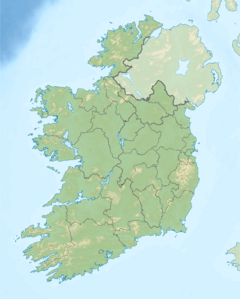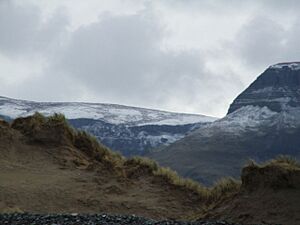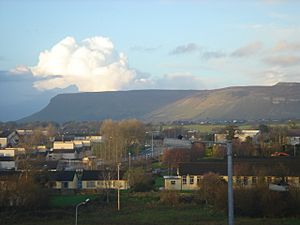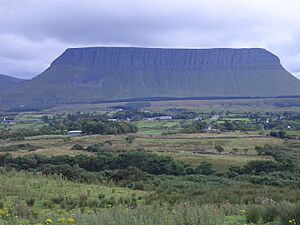Benbulbin facts for kids
Quick facts for kids Benbulbin |
|
|---|---|
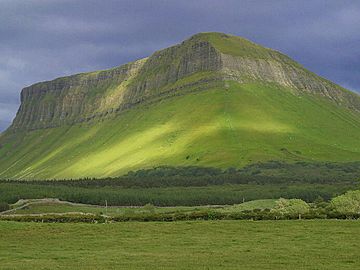
Benbulbin's northern side on a cloudy day.
|
|
| Highest point | |
| Elevation | 526 m (1,726 ft) |
| Listing | Marilyn |
| Naming | |
| Native name | Binn Ghulbain (Irish) |
| Geography | |
| Location | Sligo, Republic of Ireland |
| Parent range | Dartry Mountains |
| OSI/OSNI grid | G692463 |
| Topo map | OSi Discovery 16 |
| Climbing | |
| Easiest route | Hike |
Benbulbin, also known as Ben Bulben or Benbulben, is a famous flat-topped mountain in County Sligo, Ireland. Its Irish name is Binn Ghulbain. This unique mountain is part of the Dartry Mountains and is found in a beautiful area often called "Yeats Country."
Benbulbin is a special place. It is protected as a County Geological Site by the Sligo County Council.
Contents
What's in a Name?
The names "Ben Bulben," "Benbulben," and "Benbulbin" all come from the Irish name "Binn Ghulbain." "Binn" means "peak" or "mountain." "Ghulbain" might mean "beak" or "jaw." It could also be linked to Conall Gulban, a famous person from Irish history.
How Benbulbin Was Made
Shaped by Ice
Benbulbin got its unique shape during the ice age. Long ago, giant sheets of ice called glaciers covered Ireland. The mountain was once a flat area called a plateau. As the glaciers slowly moved, they carved and shaped the plateau. This movement from northeast to southwest gave Benbulbin its distinct look.
Mountain Rocks
Benbulbin and the other Dartry Mountains are made of different types of rock. The top layers are mostly limestone. Below the limestone, there are layers of mudstone. These rocks formed about 320 million years ago. Back then, this area was covered by a shallow sea.
The very top layer of limestone is called the Dartry Limestone Formation. It is very thick and hard. Below it is a thinner layer called the Glencar Limestone Formation. Even further down, the lower parts of the mountain are made of a soft, shaly mudstone. This is known as the Benbulben Shale Formation.
Ancient Fossils
You can find many fossils in the rocks of Benbulbin. All the rock layers contain fossilized sea shells. The shale layer also has fossils of ancient corals. This shows that the area was once under the sea.
People also mined a mineral called Baryte near Benbulbin. This mining happened between 1894 and 1979.
Climbing and Walking
Hiking the Mountain
Benbulbin is a popular place for walking and hiking. Climbing the north side of the mountain can be dangerous. This side faces strong winds and storms from the Atlantic Ocean. However, the south side is much easier to walk up. It slopes gently, making it a good hike for many people.
From the top of Benbulbin, you can see amazing views. You can look out over the flat coastal area of north County Sligo. You can also see the vast Atlantic Ocean.
Walking Trails
There are also walking trails around Benbulbin. One popular path is the Gortarowey looped walk. This trail goes through both forests and open areas. From the open parts, you can see Benbulbin and the beautiful Donegal Bay. The Gortarowey walk is about 5.5 kilometers (3.4 miles) long. It usually takes about 1.5 hours to complete.
Plants and Animals
Benbulbin is home to many different plants. Some of these plants are found nowhere else in Ireland! Many are "Arctic–alpine" plants. This means they usually grow in very cold, high places. They survived here after the glaciers melted. Wild hares and foxes also live on Benbulbin.
In 2012, scientists made an exciting discovery. They found that a plant called the fringed sandwort has lived on Benbulbin for about 100,000 years. This means it survived the Ice Age! This discovery changed what people thought about Ireland's plants and animals. Before, many believed all plants and animals came to Ireland after the Ice Age ended.
Benbulbin in History
Irish Legends
Benbulbin is part of many old Irish legends. It is said to be a hunting ground for the Fianna. The Fianna were a group of brave warriors from the 3rd century.
One famous story is about The Pursuit of Diarmuid and Gráinne. In this tale, the warrior Diarmuid Ua Duibhne is tricked by the giant Fionn mac Cumhaill (Finn McCool). Diarmuid fights an enchanted boar, which sadly kills him. Finn McCool is also said to have found his lost son Oisín here. Many believe Diarmuid and Gráinne are buried on the mountain.
In the 6th century, Saint Columba fought a battle near Benbulbin. This battle, called the Battle of Cúl Dreimhne, was over the right to copy a book of psalms.
Irish Civil War
Benbulbin also played a role in the Irish Civil War. On September 20, 1922, six Irish Republican Army (IRA) soldiers were trapped near Sligo. Their armored car was destroyed. The soldiers fled up the slopes of Benbulbin. Sadly, all six were killed by the Irish Free State's army. They are remembered as the "Noble Six."
These men were Brigadier Seamus Devins, Brian MacNeill, Captain Harry Benson, Lieutenant Paddy Carroll, Tommy Langan, and Joe Banks.
Plane Crashes
During World War II, two planes crashed in the Dartry mountains near Benbulbin.
On December 9, 1943, a USAAF B-17G Flying Fortress plane crashed on a nearby mountain called Truskmore. Three of the ten airmen on board died. Local people bravely rescued the injured. Some parts of the plane can still be found there today.
Earlier, on March 21, 1941, a RAF plane also crashed into the mountain. All nine airmen on board died in that crash.
Recent Events
In the 1970s and 1980s, political slogans were painted on Benbulbin. These included "Brits Out" and "H-Block."
Benbulbin overlooks the village of Mullaghmore. This village was where Lord Mountbatten was assassinated in 1979.
In 2018, a large "NO" sign was put on Benbulbin by campaigners. This caused a lot of discussion because Benbulbin is a protected site.
Benbulbin in Literature
Benbulbin is very important in the poems of William Butler Yeats. He was a famous Irish poet. The area around Benbulbin is even called "Yeats Country" because of his strong connection to it. The mountain is a key stop on a trail that follows the poet's life.
Yeats wrote about Benbulbin in his book The Celtic Twilight:
But for Ben Bulben and Knocknarea,
Many a poor sailor'd be cast away.
He also mentioned the mountain in his poem On a Political Prisoner. In it, he remembers Countess Markievicz riding past Benbulbin to political meetings.
Yeats's most famous poem about the area is Under Ben Bulben. It describes the sights he saw in Yeats Country. Here is a part of that poem:
Under bare Ben Bulben's head
In Drumcliff churchyard Yeats is laid.
An ancestor was rector there
Long years ago, a church stands near,
By the road an ancient cross.
No marble, no conventional phrase;
On limestone quarried near the spot
By his command these words are cut:
Cast a cold eye
On life, on death.
Horseman, pass by!
This was Yeats's last poem. It was published in The Irish Times. Yeats is buried in Drumcliffe Churchyard, right in the shadow of Benbulbin.
Images for kids
See also
 In Spanish: Montaña Benbulbin para niños
In Spanish: Montaña Benbulbin para niños


